Canon ELPH310HSBLUE, ELPH310HSSIL, ELPH310HSPURPLE, ELPH310HSPINK, ELPH310HSGREEN User Manual
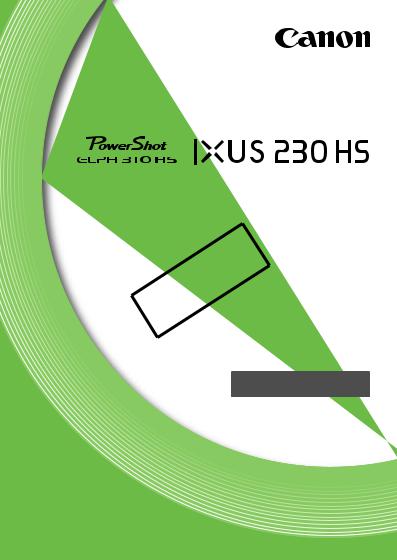
Camera User Guide
•MakeCOPYsure you read this guide, including the “Safety Precautions” section, before using the camera.
•Reading this guide will help you learn to use the camera properly.
•Store this guide safely so that you can use it in the future.
ENGLISH
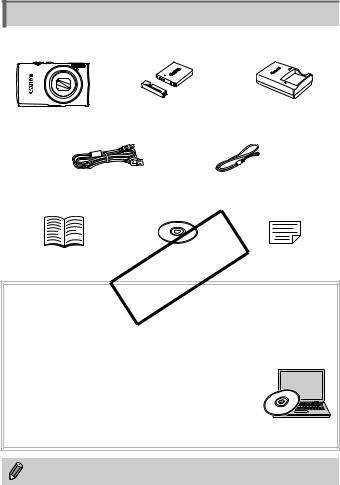
Checking the Package Contents
Check if the following items are included in your camera package.
If anything is missing, contact the retailer where you purchased the camera.
Camera |
Battery Pack NB-4L |
Battery Charger |
(with Terminal Cover) |
CB-2LV/CB-2LVE |
Using the PDF Manuals
|
Interface Cable |
Wrist Strap |
||
|
IFC-400PCU |
WS-DC11 |
||
Getting Started |
|
DIGITAL CAMERA |
Warranty Card |
|
|
|
|
Solution Disk |
|
ROM: |
|
COPY |
|
|
The following PDF manuals are included in the Readme folder of the CD-
When the software is installed on your computer, the PDF manuals will be copied to the computer and you can refer to them by clicking the shortcuts on the desktop.
• Camera User Guide (This Guide)
Once you have mastered the basics, use the camera’s many features to shoot more challenging photos.
• Software Guide
Read when you want to use the included software.
• A memory card is not included (p. 16).
• Adobe Reader is required to view the PDF manuals.
2
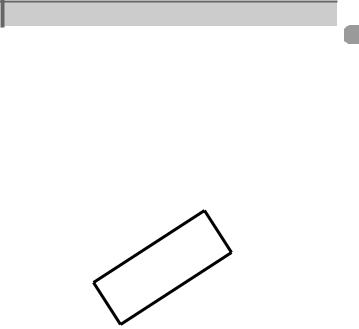
Read This First
•Take some initial test shots and play them back to make sure the images were recorded correctly. Please note that Canon Inc., its subsidiaries and affiliates, and its distributors are not liable for any consequential damages arising from any malfunction of a camera or accessory, including memory cards, that results in the failure of an image to be recorded or to be recorded in a way that is machine readable.
•The images recorded with this camera are intended for personal use. Do not record images that infringe upon copyright laws without the prior permission of the copyright holder. Please be advised that in certain cases the copying of images from performances, exhibitions, or commercial properties by means of a camera or other device may contravene copyright or other legal rights even if the image was shot for personal use.
•This camera’s warranty is only effective in the country of sale. If there is a problem with the camera while abroad, please return it to the country of sale before proceeding with a warranty claim to a Canon Customer Support Help Desk. For Canon Customer Support contacts, please see the customer support list supplied with your camera.
•The LCD monitor is produced with extremely high-precision manufacturing techniques. More thanCOPY99.99% of the pixels operate to specification, but occasionally non-performing pixels may appear as bright or dark dots. This is not a malfunction and has no effect on the recorded image.
•The LCD monitor may be covered with a thin plastic film for protection against scratches during shipment. If covered, remove the film before using the camera.
•Please take care when operating the camera for an extended period as the camera body may become warm. This is not a malfunction.
3
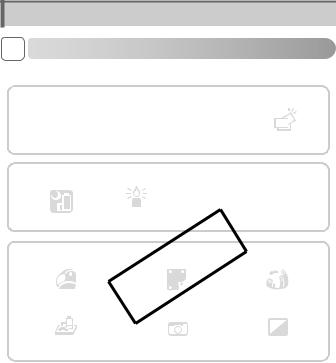
What Do You Want to Do?
4 Shoot
z Shoot, leaving it to the camera to make settings (Auto mode) ..... 26
Take good people shots
Portraits |
Kids and Pets |
Against Snow |
Facial Expressions |
|
I |
V |
At wthe Beach |
P |
|
(p. 62) |
(p. 62) |
(p. 63) |
(p. 63) |
(p. 79) |
Shoot various other scenes |
OFoliage |
Fireworkst |
||
Night Scenes |
Low Light |
|||
(p. 63) |
(p. 63) |
(p. 63) |
(p. 64) |
|
|
COPY |
|
Shoot with special effects |
|
|
Vivid Colors (p. 65) |
Poster Effect |
Fish-eye Effect |
|
(p. 65) |
(p. 66) |
Miniature Effect |
Toy Camera Effect |
Monochrome |
(p. 66) |
(p. 67) |
(p. 68) |
z Focus on faces ................................................................. |
26, 62, 92 |
z Shoot in places where I cannot use the flash (turn off the flash) .. 52 |
|
z Take pictures with me in them too (self-timer)........................ |
55, 75 |
z Insert the date and time into my shots.......................................... |
54 |
z Shoot a movie clip just before taking a picture ............................. |
72 |
4
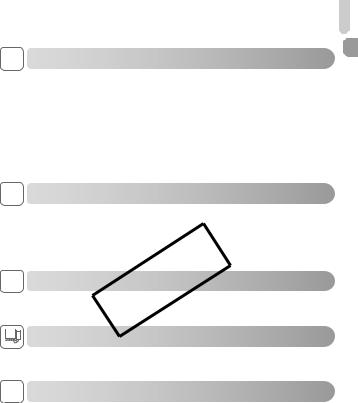
|
|
What Do You Want to Do? |
1 View |
|
|
z Look at my pictures ...................................................................... |
29 |
|
z Automatically play back pictures (slideshow) |
............................. 117 |
|
z Look at my pictures on a TV....................................................... |
170 |
|
z Look at my pictures on a computer .............................................. |
34 |
|
z Quickly search pictures .............................................................. |
114 |
|
z Erase pictures....................................................................... |
|
30, 128 |
E Shoot/View Movies |
|
|
z Shoot movies........................................................................ |
|
31, 103 |
z View movies ................................................................................. |
|
33 |
z Shoot fast moving subjects and play them back in slow motion... 106 |
||
c Print |
|
|
z Print pictures............................................................................... |
|
142 |
|
COPY |
|
Save |
|
|
z Save images to a computer.......................................................... |
34 |
|
3 Other |
|
|
z Turn off sounds............................................................................. |
|
46 |
z Use the camera abroad ........................................................ |
16, 164 |
|
z Understand what is displayed on the screen.............................. |
183 |
|
5
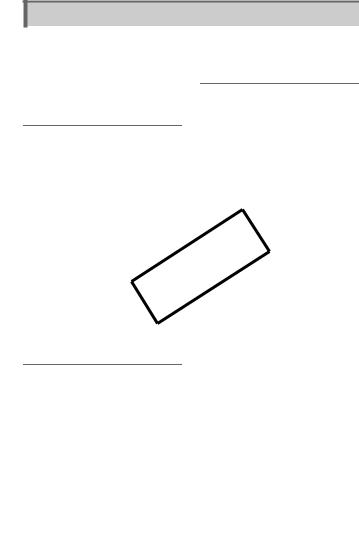
Table of Contents
Checking the Package Contents |
.......2 |
Read This First .................................. |
3 |
What Do You Want to Do? ................ |
4 |
Table of Contents .............................. |
6 |
Conventions Used in This Guide ....... |
9 |
Safety Precautions........................... |
10 |
1 Getting Started ................. |
13 |
Charging the Battery........................ |
14 |
Compatible Memory Cards |
|
(Sold Separately)........................... |
16 |
Inserting the Battery and |
|
Memory Card................................. |
17 |
Setting the Date and Time ............... |
20 |
Power Saving Function |
|
(Auto Power Down)....................... |
50 |
Clock Function ................................ |
50 |
3 Shooting with Commonly |
|
Used Functions ................ |
51 |
Turning the Flash Off ...................... |
52 |
Zooming In More Closely on |
|
Subjects (Digital Zoom)................. |
53 |
Inserting the Date and Time............ |
54 |
Using the Self-Timer ....................... |
55 |
Changing the Aspect Ratio ............. |
58 |
Changing the Recording Pixel |
|
Setting (Image Size) ..................... |
59 |
Setting the Display Language.......... |
22 |
Changing the Compression Ratio |
59 |
|
Formatting Memory Cards |
|
23 |
(Image Quality) ............................. |
|
|
|
|
||
Pressing the Shutter Button............. |
|
25 |
|
|
|
4 Adding Effects and |
|
||
Taking Pictures (Smart Auto)........... |
26 |
|
||
Viewing Images ............................... |
|
29 |
Shooting in Various |
61 |
Erasing Images |
|
30 |
Conditions ........................ |
|
|
|
|
||
Shooting Movies .............................. |
|
31 |
Shooting in Various Conditions ....... |
62 |
Viewing Movies................................ |
COPY33 Adding Effects and Shooting........... |
65 |
||
Transferring Images to a Computer |
|
for Viewing..................................... |
34 |
2 Learning More .................. |
39 |
Components Guide.......................... |
40 |
Screen Display................................. |
42 |
Indicator ........................................... |
43 |
FUNC. Menu – Basic Operations .... |
44 |
MENU – Basic Operations............... |
45 |
Changing the Sound Settings.......... |
46 |
Adjusting the Screen Brightness...... |
48 |
Returning the Camera to Default |
|
Settings.......................................... |
49 |
Making Short Movies Automatically |
|
(Movie Digest)............................... |
72 |
Detecting a Face and Shooting |
|
(Smart Shutter) ............................. |
73 |
Shooting Long Exposures ............... |
77 |
High-Speed Continuous Shooting |
|
(High-speed Burst)........................ |
78 |
Capturing the Best Facial |
|
Expressions (Best Image |
|
Selection) ...................................... |
79 |
Shooting Stitch Assist Images......... |
80 |
6
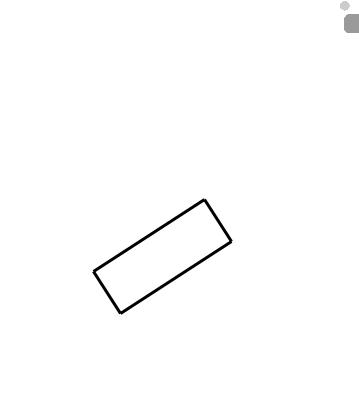
|
|
|
|
Table of Contents |
|
||
|
|
|
|
Shoot Movies That Look Like a |
|
|
|
5 Choosing Settings |
|
|
|
|
|
||
81 |
Miniature Model |
|
|
|
|||
Yourself............................. |
|
(Miniature Effect)......................... |
105 |
|
|
||
Shooting in Program AE ................. |
|
82 |
|
Shooting Super Slow Motion |
|
|
|
Adjusting the Brightness |
|
|
|
Movies......................................... |
106 |
|
|
(Exposure Compensation) ............ |
83 |
|
Changing the Image Quality.......... |
108 |
|
||
Turning the Flash On ...................... |
|
83 |
|
Using the Wind Filter ..................... |
109 |
|
|
Adjusting the White Balance........... |
84 |
|
Other Shooting Functions.............. |
110 |
|
|
|
Changing the ISO Speed................ |
85 |
|
Editing ........................................... |
111 |
|
|
|
Correcting the Brightness and |
|
|
|
|
|
|
|
.....................Shooting (i-Contrast) |
|
86 |
|
7 Using Various Playback and |
|
|
|
Continuous Shooting....................... |
|
87 |
Editing Functions........... |
113 |
|
||
Changing the Tone of an Image |
|
|
Quickly Searching Images |
114 |
|
|
|
(My Colors) |
|
88 |
|
|
|
||
|
|
Viewing Images in Filtered |
|
|
|
||
Shooting Close-ups (Macro) |
90 |
|
|
|
|
||
|
Playback |
115 |
|
|
|||
Shooting Far Away Subjects |
|
|
|
|
|||
|
|
Viewing Slideshows |
117 |
|
|
||
(Infinity) |
|
90 |
|
|
|
||
|
|
Checking the Focus |
119 |
|
|
||
Changing the AF Frame Mode |
92 |
|
|
|
|||
|
Magnifying Images |
120 |
|
|
|||
Choosing the Subject to Focus On |
|
|
|||||
Viewing Each Image in a Group |
121 |
|
|
||||
(Tracking AF) ................................ |
|
94 |
|
|
|
||
Magnifying the Focal Point.............. |
95 |
|
Displaying Various Images |
123 |
|
|
|
Shooting with the AF Lock |
96 |
|
(Smart Shuffle) ............................ |
|
|
||
|
Changing Image Transitions |
124 |
|
||||
Shooting with Servo AF |
|
97 |
|
|
|||
|
|
|
124 |
|
|
||
|
COPYProtecting Images ......................... |
|
|
||||
Changing the Metering Method....... |
98 |
|
Erasing Images |
128 |
|
|
|
Shooting with the AE Lock |
99 |
|
|
|
|||
|
Tagging Images as Favorites |
130 |
|
||||
Shooting with the FE Lock |
99 |
|
|
||||
|
Organizing Images by Category |
|
|
|
|||
Shooting with Slow Synchro |
100 |
|
|
|
|||
(My Category) |
132 |
|
|
||||
Red-Eye Correction |
|
101 |
|
|
|||
|
Rotating Images |
135 |
|
||||
Checking for Shut Eyes |
|
102 |
|
||||
|
Resizing Images |
136 |
|
|
|||
|
|
|
|
|
|
||
|
|
|
|
Trimming ....................................... |
137 |
|
|
6 Using Various Functions for |
|
||||||
Adding Effects with the My Colors |
|
|
|
||||
Shooting Movies ............ |
103 |
Function ...................................... |
138 |
|
|
||
Shooting Various Kinds of |
|
|
Correcting the Brightness |
|
|
|
|
Movies ........................................ |
|
104 |
(i-Contrast) .................................. |
139 |
|
||
|
|
|
|
Correcting the Red-Eye Effect....... |
140 |
|
|
7
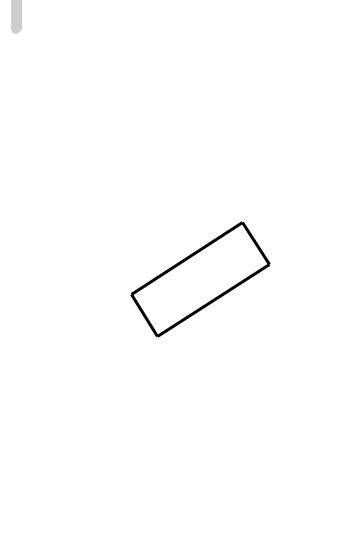
Table of Contents
8 Printing............................ |
141 |
|
10 Useful Information ......... |
169 |
|
Printing Images.............................. |
142 |
Viewing Images on a TV ............... |
170 |
||
Choosing Images for Printing |
|
|
Using Household Power................ |
174 |
|
(DPOF) ........................................ |
149 |
Using an Eye-Fi Card.................... |
175 |
||
Choosing Images for a |
154 |
Troubleshooting ............................ |
177 |
||
Photobook ................................... |
List of Messages That Appear |
|
|||
|
|
|
|
||
|
|
|
on the Screen.............................. |
180 |
|
9 Customizing Camera |
|
|
Information Displayed |
|
|
Settings........................... |
157 |
|
on the Screen.............................. |
183 |
|
Changing Camera Settings |
158 |
Functions and Menu Lists ............. |
188 |
||
Handling Precautions |
197 |
||||
Changing Shooting Function |
|
|
|||
|
|
Specifications |
198 |
||
Settings........................................ |
165 |
||||
Changing Playback Function |
|
|
Accessories................................... |
202 |
|
Settings........................................ |
168 |
Separately Sold Accessories ........ |
203 |
||
|
|
|
Index ............................................. |
205 |
|
COPY |
|
||||
8
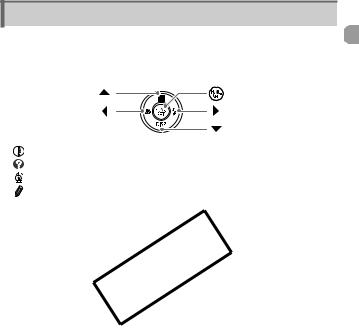
Conventions Used in This Guide
•Icons are used in the text to represent the camera buttons and switches.
•Language that displays on the screen appears inside [ ] (square brackets).
•The directional buttons and FUNC./SET button are represented by the following icons.
|
Up Button |
FUNC./SET Button |
|
Left Button |
Right Button |
|
|
Down Button |
• |
: Things you should be careful about |
|
• |
: Troubleshooting tips |
|
• |
: Hints for getting more out of your camera |
|
• |
: Supplemental information |
|
• (p. xx): Reference pages (“xx” stands for a page number)
• |
This guide assumes all functions are at their default settings. |
• |
The various types of memory cards that can be used in this camera are |
|
collectively referred to as memory cards in this guide. |
|
COPY |
9
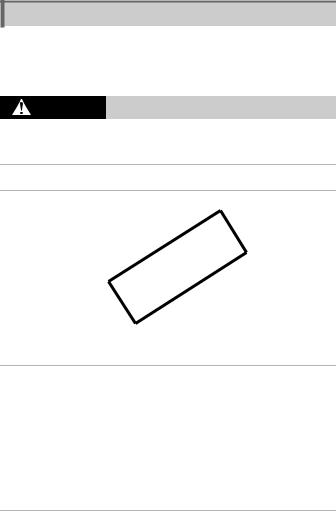
Safety Precautions
•Before using the product, please ensure that you read the safety precautions described below. Always ensure that the product is used correctly.
•The safety precautions noted on the following pages are intended to prevent injuries to yourself and other persons, or damage to the equipment.
•Be sure to also check the guides included with any separately sold accessories you use.
Warning Denotes the possibility of serious injury or death.
• Do not trigger the flash in close proximity to people’s eyes.
Exposure to the intense light produced by the flash could damage eyesight. In particular, remain at least 1 meter (39 inches) away from infants when using the flash.
•Store this equipment out of the reach of children and infants.
Strap: Putting the strap around a child’s neck could result in asphyxiation.
•Use only recommended power sources.
•Do not attempt to disassemble, alter or apply heat to the product.
•Avoid dropping or subjecting the product to severe impacts.
•To avoid the risk of injury, do not touch the interior of the product if it has been dropped or otherwise damaged.
•Stop using the product immediatelyCOPYif it emits smoke, a strange smell, or otherwise behaves abnormally.
•Do not use organic solvents such as alcohol, benzine, or thinner to clean the product.
•Do not let the product come into contact with water (e.g. sea water) or other liquids.
•Do not allow liquids or foreign objects to enter the camera.If liquids or foreign objects come into contact with the camera interior, immediately turn
the camera off and remove the battery.
If the battery charger becomes wet, unplug it from the outlet and consult your camera distributor or a Canon Customer Support Help Desk.
•Use only the recommended battery.
•Do not place the battery near or in direct flame.
•Unplug the power cord periodically, and using a dry cloth, wipe away any dust and dirt that has collected on the plug, the exterior of the power outlet, and the surrounding area.
•Do not handle the power cord with wet hands.
•Do not use the equipment in a manner that exceeds the rated capacity of the electrical outlet or wiring accessories. Do not use if the power cord or plug are damaged, or not fully plugged into the outlet.
•Do not allow dirt or metal objects (such as pins or keys) to contact the terminals or plug.
The battery may explode or leak, resulting in electrical shock or fire. This could cause injury and damage the surroundings. In the event that a battery leaks and the battery electrolyte contacts eyes, mouth, skin or clothing, immediately flush with water.
10

Safety Precautions
• Turn the camera off in places where camera use is prohibited.
The electromagnetic waves emitted by the camera may interfere with the operation of electronic instruments and other devices. Exercise adequate caution when using the camera in places where use of electronic devices is restricted, such as inside airplanes and medical facilities.
• Do not play the supplied CD-ROM(s) in any CD player that does not support data CD-ROMs.
It is possible to suffer hearing loss from listening with headphones to the loud sounds of a CD-ROM played on an audio CD player (music player). Additionally, this could damage the speakers.
Caution Denotes the possibility of injury.
•When holding the camera by the strap, be careful not to bang it, subject it to strong impacts or shocks, or let it get caught on other objects.
•Be careful not to bump or push strongly on the lens.
This could lead to injury or damage the camera.
•When using the flash, beCOPYcareful not to cover it with your fingers or clothing.
This could result in burns or damage to the flash.
•Avoid using, placing or storing the product in the following places:
-Places subject to strong sunlight
-Places subject to temperatures above 40 °C (104 °F)
-Humid or dusty areas• Be careful not to subject the screen to strong impacts.
These could cause leakage, overheating or an explosion of the battery, resulting in electrical shock, fire, burns or other injuries.
High temperatures may cause deformation of the camera or battery charger casing.
•The slideshow transition effects may cause discomfort when viewed for prolonged periods.
Caution Denotes the possibility of damage to the equipment.
•Do not aim the camera at bright light sources (such as the sun on a clear day).
Doing so may damage the image sensor.
•When using the camera on a beach or at a windy location, be careful not to allow dust or sand to enter the camera.
This may cause the product to malfunction.
11
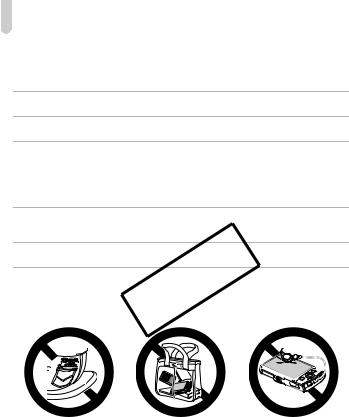
Safety Precautions
• In regular use, small amounts of smoke may be emitted from the flash.
This is due to the high intensity of the flash burning dust and foreign materials stuck to the front of the unit. Please use a cotton swab to remove dirt, dust or other foreign matter from the flash to prevent heat build-up and damage to the unit.
• Remove and store the battery when you are not using the camera.
If the battery is left inside the camera, damage caused by leakage may occur.
•Before you discard the battery, cover the terminals with tape or other insulators.
Contacting other metal materials may lead to fire or explosions.
•Unplug the battery charger from the power outlet after charging is complete, or when you are not using it.
•Do not place anything, such as cloth on top of the battery charger while it is
charging.
Leaving the unit plugged in for a long period of time may cause it to overheat and distort, resulting in fire.
• Do not place the battery near pets.
Pets biting the battery could cause leakage, overheating or explosion, resulting in fire or damage.
•Do not sit down with the camera in your pocket.
Doing so may cause malfunctionsCOPYor damage the screen.
•When putting the camera in your bag, ensure that hard objects do not come into contact with the screen.
•Do not attach any hard objects to the camera.
12
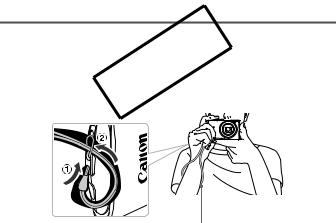
1 
Getting Started
This chapter explains preparations before shooting, how to shoot in Amode, and then how to view and erase the images you take. The latter part of this chapter explains how to shoot and view movies and transfer images to a computer.
•Attach the included strapCOPYand wrap it around your wrist to avoid dropping the camera during use.
•Keep your arms tight against your body while holding the camera firmly by the sides when shooting. Be sure that your fingers do not block the flash.
Strap
13
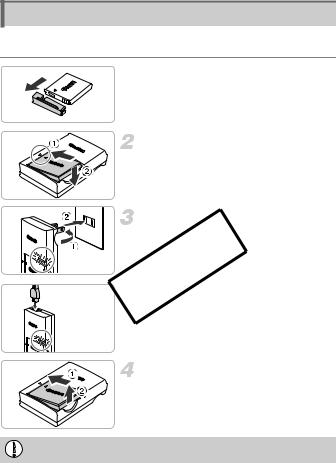
Charging the Battery
Use the included charger to charge the battery. Be sure to charge the battery as it is not charged at the time of purchase.
 Remove the cover.
Remove the cover.
CB-2LV
CB-2LVE
Insert the battery.
zAlign the S marks on the battery and charger, then insert the battery by sliding it in ( ) and down (
) and down ( ).
).
Charge the battery.
z For CB-2LV: Flip out the plug ( ) and COPYplug the charger into a power outlet (
) and COPYplug the charger into a power outlet ( ).
).
z For CB-2LVE: Plug the power cord into the charger, then plug the other end into a power outlet.
XThe charge lamp lights orange and charging starts.
XThe charge lamp will light green when charging has finished. Charging takes approx. 1 hour and 30 minutes.
Remove the battery.
z Unplug the battery charger from the power outlet, then remove the battery by sliding it in ( ) and up (
) and up ( ).
).
To protect the battery and prolong its life, do not charge it for longer than 24 hours continuously.
14
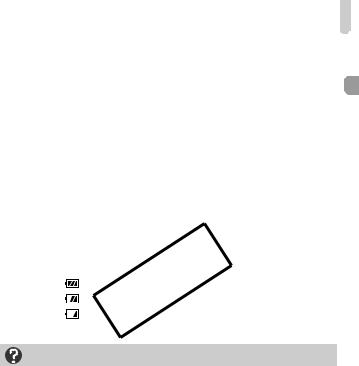
Charging the Battery
Number of Possible Shots/Shooting and Playback Times
Number of Shots*1 |
Approx. 210 |
|
Movie Shooting Time*2 |
Approx. 40 minutes |
|
Continuous |
Approx. 1 hour 10 minutes |
|
Shooting*3 |
||
|
||
Playback Time |
Approx. 4 hours |
*1 The number of shots that can be taken is based on the Camera & Imaging Products Association (CIPA) measurement standard.
*2 Times are based on default settings, starting and stopping shooting, turning the camera on and off, and operations such as using the zoom.
*3 Times are based on repeatedly shooting until the maximum clip length is reached or recording stops automatically.
•Under some shooting conditions, the number of possible shots and shooting time may be less than mentioned above.
Battery Charge Indicator
An icon or message will appear on the screen indicating the battery’s charge
state. |
|
|
|
|
|
|
|
|
|
|
Display |
COPY |
Summary |
|
|
|
|
||
|
|
|
Sufficient charge. |
|
|
|
|
|
|
|
|
|
Slightly depleted, but sufficient. |
|
|
|
|
||
|
(Blinking red) |
Nearly depleted. Charge the battery. |
||
|
|
|||
“Change the battery pack.” |
Depleted. Charge the battery. |
|||
|
|
|
|
|
What if...
•What if the battery develops a bulge?
This is a normal characteristic of the battery and does not indicate a problem. However, if the battery bulges to the point where it will no longer fit into the camera, please contact a Canon Customer Support Help Desk.
•What if the battery is quickly depleted even after charging?
The battery has reached the end of its life span. Purchase a new battery.
15
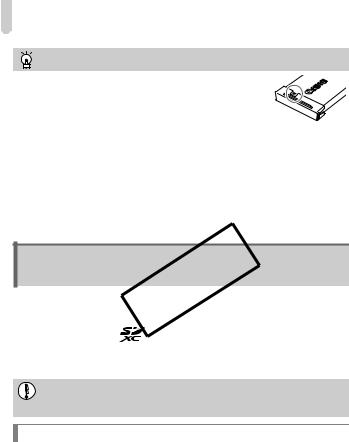
Compatible Memory Cards (Sold Separately)
Using the battery and charger effectively
• Charge the battery on the day, or the day before, it will be used.
Charged batteries continue to discharge naturally even if they are not used.
Attach the cover to a charged battery so that the S mark is visible.
•How to store the battery for long periods:
Deplete and remove the battery from the camera. Attach the terminal cover and store the battery. Storing a battery for long periods of time (about a year) without depleting it may shorten its life span or affect its performance.
•The battery charger can also be used when abroad.
The charger can be used in regions that have 100 – 240 V (50/60 Hz) AC power. If the plug does not fit the outlet, use a commercially available plug adapter. Do not use electrical transformers for foreign travel as they will cause damage.
Compatible Memory Cards (Sold
Separately)
The cards below can be used without restrictions on their capacities.
• |
SD memory cards* |
COPY* |
• |
SDHC memory cards* |
|
• |
SDXC memory cards |
• Eye-Fi cards
*This memory card complies with SD standards. Some cards may not operate properly depending on the brand of card used.
Depending on your computer’s OS version, SDXC memory cards may not be recognized even when using a commercially available card reader. Check to make sure that your OS supports SDXC memory cards beforehand.
About Eye-Fi Cards
This product is not guaranteed to support Eye-Fi card functions (including wireless transfer). In case of an issue with an Eye-Fi card, please check with the card manufacturer.
Also note that an approval is required to use Eye-Fi cards in many countries or regions. Without approval, use of the card is not permitted. If it is unclear whether the card has been approved for use in the area, please check with the card manufacturer.
16
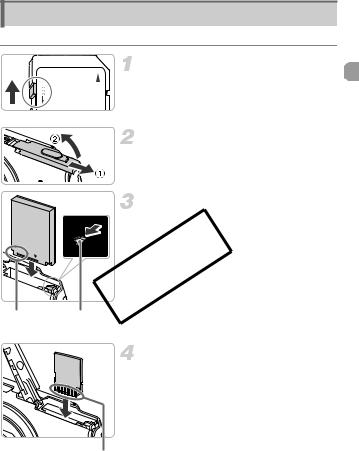
Inserting the Battery and Memory Card
Insert the included battery and a memory card (sold separately).
Check the card’s write-protect tab.
z If the memory card has a write-protect tab, you will not be able to record images if the tab is in the locked position. Slide the tab up until you hear a click.
Terminals |
Battery |
|
Lock |
Open the cover.
z Slide the cover ( ) and open it (
) and open it ( ).
).
Insert the battery.
z Press the battery lock in the direction of the arrow, then insert the battery as shown
until it locks into place with a click. COPYz Be sure to insert the battery in the correct
direction or it will not properly lock into place.
Insert the memory card.
zInsert the memory card as shown until it locks into place with a click.
zBe sure the memory card is oriented correctly. Inserting the memory card in the
wrong direction could damage the camera.
Terminals
17
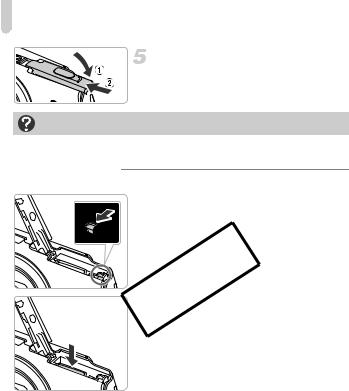
Inserting the Battery and Memory Card
Close the cover.
z Close the cover ( ), and press downward as you slide it until it clicks into place (
), and press downward as you slide it until it clicks into place ( ).
).
What if [Memory card locked] appears on the screen?
If the write-protect tab is in the locked position, [Memory card locked] will appear on the screen and you will not be able to take or erase images.
 Removing the Battery and Memory Card
Removing the Battery and Memory Card
Remove the battery.
z Open the cover and press the battery lock
in the direction of the arrow. XThe battery will pop up.
COPYRemove the memory card.
z Push the memory card in until you hear a click, then slowly release it.
XThe memory card will pop up.
18
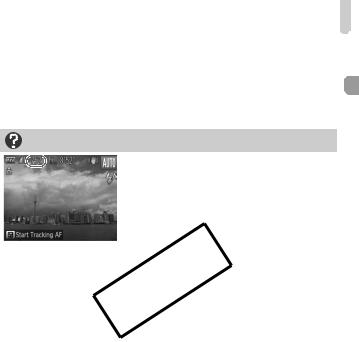
Inserting the Battery and Memory Card
Number of Shots per Memory Card
Memory Card |
4 GB |
16 GB |
Number of Shots |
Approx. 1231 |
Approx. 5042 |
•Values are based on the default settings.
•The number of shots that can be taken will vary depending on camera settings, the subject and the memory card used.
Can you check the number of shots that can be taken?
You can check the number of shots that can be taken when the camera is in a Shooting mode (p. 26).
COPY
19
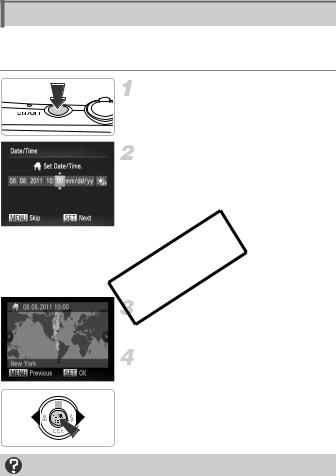
Setting the Date and Time
The Date/Time settings screen will appear the first time the camera is turned on. Since the dates and times recorded into your images are based on these settings, be sure to set them.
Turn on the camera.
z Press the power button.
XThe Date/Time screen will appear.
Set the date and time.
zPress the qrbuttons to choose an option.
zPress the op buttons to set a value.
zOnce all settings are complete, press the m button.
 COPYSet the home time zone.
COPYSet the home time zone.
Press the buttons to choose your
qr
z
home time zone.
Complete the setting.
zPress the m button to complete the setting. After a confirmation screen appears, the shooting screen will reappear.
zPressing the power button will turn off the camera.
Reappearing Date/Time screen
Set the correct date and time. If you have not set the date and time and the home time zone, the Date/Time screen will appear each time you turn on the camera.
20
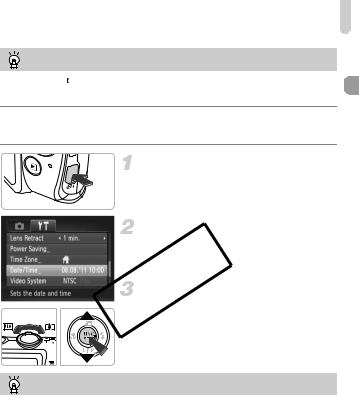
Setting the Date and Time
Daylight saving time settings
If you choose  in Step 2 on p. 20 and press the op buttons to choose
in Step 2 on p. 20 and press the op buttons to choose  , you will set the time to daylight saving (1 hour ahead).
, you will set the time to daylight saving (1 hour ahead).
 Changing the Date and Time
Changing the Date and Time
You can change the current date and time settings.
Display the menu.
z Press the n button.
Choose [Date/Time].
z Move the zoom lever to choose the 3tab. z Press the op buttons to choose [Date/
COPYTime], then press the m button.
Change the date and time.
z Follow Step 2 on p. 20 to adjust the settings.
z Press the nbutton to close the menu.
Date/Time battery
•The camera has a built-in date/time battery (backup battery) that allows the date/time settings to be retained for about 3 weeks after the battery pack has been removed.
•By inserting a charged battery or connecting an AC adapter kit (sold separately, p. 203) the date/time battery can be charged in about 4 hours even if the camera is not turned on.
•If the date/time battery is depleted, the Date/Time screen will appear when you turn the camera on. Follow the steps on p. 20 to set the date and time.
21
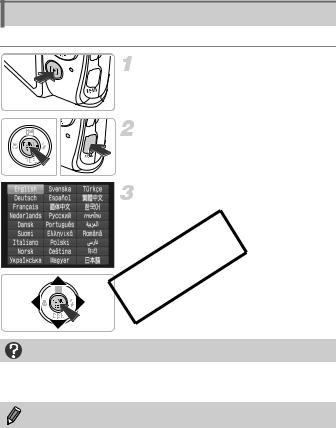
Setting the Display Language
You can change the language that displays on the screen.
Enter Playback mode. z Press the 1 button.
Display the settings screen.
z Press and hold the m button, then immediately press the n button.
Set the display language.
z Press the opqr buttons to choose a language, then press the m button.
XOnce the display language has been set, COPYthe settings screen will close.
What if the clock appears when the m button is pressed?
The clock will appear if too much time passes between pressing the m button and the n button in Step 2. If the clock appears, press the m button to remove the clock and repeat Step 2.
You can also change the display language by pressing the n button to choose [Language  ] in the 3 tab.
] in the 3 tab.
22
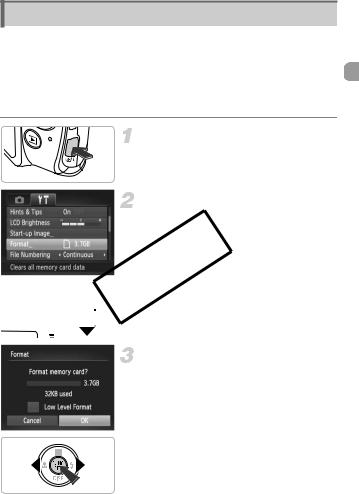
Formatting Memory Cards
Before you use a new memory card or one that has been formatted in other devices, you should format the card with this camera.
Formatting (initializing) a memory card erases all data on the memory card. As you cannot retrieve the erased data, exercise adequate caution before formatting the memory card.
Before formatting an Eye-Fi card (p. 175), be sure to install the software contained on the card to a computer.
Display the menu.
z Press the n button.
Choose [Format].
z Move the zoom lever to choose the 3tab. z Press the opbuttons to choose [Format],
then press the m button.  COPY
COPY
Choose [OK].
z Press the qrbuttons to choose [OK], then press the m button.
23
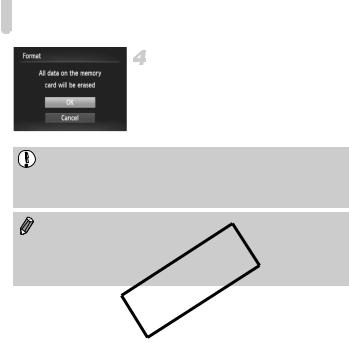
Formatting Memory Cards
Format the memory card.
zPress the op buttons to choose [OK], then press the m button to start formatting.
zWhen formatting ends, [Memory card formatting complete] appears on the screen. Press the m button.
Formatting or erasing data on a memory card merely changes the file management information on the card and does not ensure its contents are completely erased. Be careful when transferring or disposing of a memory card. When disposing of a memory card, take precautions such as physically destroying the card to prevent personal information leaks.
• The total capacity of the memory card displayed in the formatting screen may be less than indicated on the memory card.
•Perform a low-level format (p. 159) of the memory card when the camera
does not operate properly, the recording/reading speed of a memory card has dropped, when COPYcontinuous shooting speed slows down, or when movie recording stops suddenly.
24
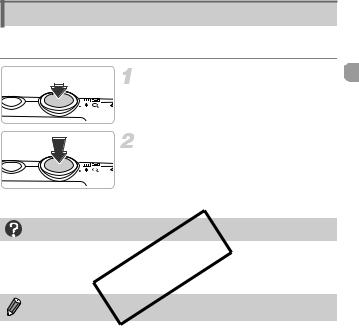
Pressing the Shutter Button
To take images that are in focus, be sure to first press the shutter button lightly (halfway) to focus, then press fully to shoot.
Press halfway (Press lightly to focus).
z Press lightly until the camera beeps twice and AF frames appear where the camera focused.
Press fully (Press fully to shoot).
XThe camera plays the shutter sound and takes the shot.
zSince the shot is being taken while the shutter sound plays, be careful not to move the camera.
Does the length of the shutter sound change?
•Since the time requiredCOPYto shoot differs depending on the scene you want to take, the length of the shutter sound may change.
•If the camera or subject moves while the shutter sound is playing, the recorded image may be blurry. not
25
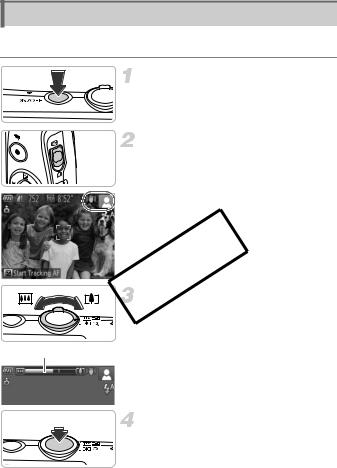
Taking Pictures (Smart Auto)
Since the camera can determine the subject and shooting conditions, you can let it automatically select the best settings for the scene and just shoot.
Turn on the camera.
z Press the power button.
XThe start-up screen will appear.
Enter A mode.
z Set the mode switch to A.
z When you point the camera toward the subject, the camera will make a slight noise as it determines the scene.
XThe icon for the determined scene, and the IS mode icon will appear in the upper right of the screen (pp. 184, 185).
XThe camera will focus on detected subjects and display frames on them.
|
ompose the shot. |
|
|
z Moving the zoom lever toward i |
|
|
COPY(telephoto) will zoom in on your subject, |
|
|
making it appear larger. Moving the lever |
|
Zoom Bar |
toward j(wide angle) will zoom out from |
|
your subject, making it appear smaller. |
||
|
||
|
(The zoom bar showing the zoom position |
|
|
appears on the screen.) |
|
|
Focus. |
|
|
z Press the shutter button halfway to focus. |
26
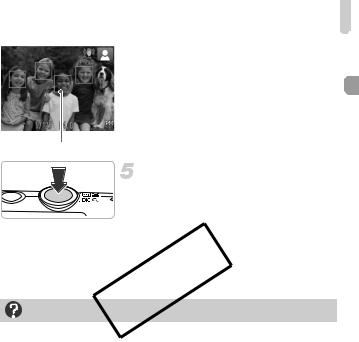
Taking Pictures (Smart Auto)
XWhen the camera focuses, it will beep twice and AF frames will appear where the camera focused.
Several AF frames will appear when the camera focuses on more than 1 point.
AF Frame
Shoot.
z Press the shutter button fully to shoot.
XThe camera will play the shutter sound and shoot. The flash will automatically fire in low light conditions.
XThe image will appear on the screen for approximately 2 seconds.
•What if the color andCOPYbrightness of the images do not turn out as expected?
The scene icon (p. 184) that appears on the screen may not match the actual
scene, and you may not obtain the expected results. If this happens, try shooting in G mode (p. 81).
•What if white and gray frames appear when you point the camera toward a subject?
A white frame appears on the face or subject that the camera detected as the main subject, while gray frames appear on other detected faces. The frames will follow the subjects within a certain range.
If the subject moves, however, the gray frames will disappear, leaving only the white frame.
•What if a frame does not appear on the subject you want to shoot?
The subject may not be detected, and frames may appear on the background. If this happens, try shooting in G mode (p. 81). while
27
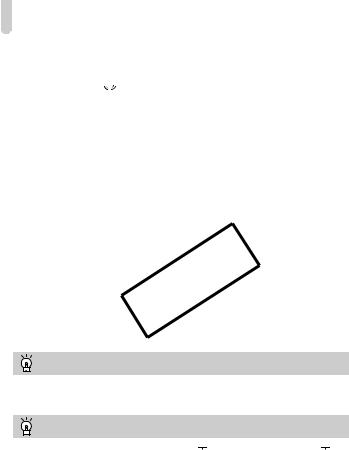
Taking Pictures (Smart Auto)
•What if a blue frame appears when you press the shutter button halfway?
A blue frame appears when a moving subject is detected; the focus and exposure will continuously adjust (Servo AF).
•What if a flashing  appears?
appears?
Attach the camera to a tripod so that the camera does not move and blur the image.
•What if the camera does not play any sounds?
You may have been pressing the pbutton while turning on the camera, which
will turn off all sounds except for warning sounds. To turn the sounds on, press the n button to choose [Mute] in the 3 tab, then press the qr buttons to choose [Off].
•What if the image comes out dark even if the flash fired when shooting?
The subject is too far away for the flash to reach. The effective flash range is approximately 50 cm – 4.0 m (1.6 – 13 ft.) at maximum wide angle (j), and approximately 50 cm – 2.0 m (1.6 – 6.6 ft.) at maximum telephoto (i).
•What if the camera beeps once when the shutter button is pressed halfway?
Your subject may be too close. When the camera is at maximum wide angle (j), move about 1 cm (0.4COPYin.) or more away from your subject and shoot. Move about 1 m (3.3 ft.) or more away when the camera is at maximum telephoto (i).
•What if the lamp lights when the shutter button is pressed halfway?
To reduce red-eye and to assist in focusing, the lamp may light when shooting in low light conditions.
•What if the h icon blinks when you try to shoot?
The flash is charging. You can shoot when recharging ends.
Icons that appear on the screen
The icon for the determined scene, and the IS mode icon will appear on the screen. For details on the icons that appear, see “Scene Icons” (p. 184) and “IS Mode Icons” (p. 185).
Choosing the subject to focus on (Tracking AF)
After pressing the o button and displaying 

 , point the camera so that
, point the camera so that 

 is on the subject you want to focus on. Press and hold the shutter button halfway to display a blue frame where focus and exposure will be maintained (Servo AF).
is on the subject you want to focus on. Press and hold the shutter button halfway to display a blue frame where focus and exposure will be maintained (Servo AF).
Press the shutter button fully to shoot.
28
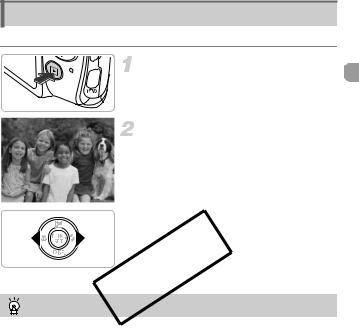
Viewing Images
You can view the images you have taken on the screen.
Enter Playback mode.
z Press the 1 button.
XThe last image you took will appear.
Choose an image.
zPressing the q button will cycle through the images from newest to oldest.
zPressing the r button will cycle through the images from oldest to newest.
zPressing and holding the qr buttons will
display images in a line letting you quickly search them. Pressing the m button
restores single image playback (p. 114). z The lens will retract after approximately 1
COPYminute elapses.
z ressing the 1 button again while the lens is retracted will turn the camera off.
Switching to Shooting mode
Pressing the shutter button halfway while in Playback mode switches the camera to Shooting mode.
29
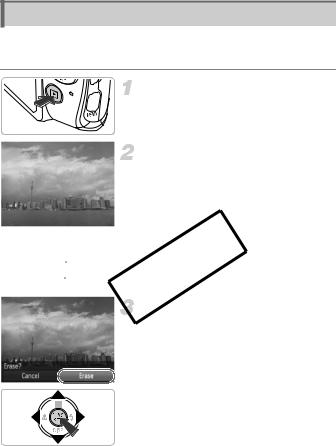
Erasing Images
You can choose and erase images one at a time. Please note that erased images cannot be recovered. Exercise adequate caution before erasing an image.
Enter Playback mode.
z Press the 1 button.
XThe last image you took will appear.
Choose an image to erase.
zPress the qrbuttons to display an image to erase.
 COPYErase the image.
COPYErase the image.
After pressing the button, press the
z op m a
buttons to choose , then press the m button again.
z When [Erase?] appears on the screen, press the qr buttons to choose [Erase], then press the m button.
XThe displayed image will be erased.
zTo exit instead of erasing, press the qr buttons to choose [Cancel], then press the
m button.
30
